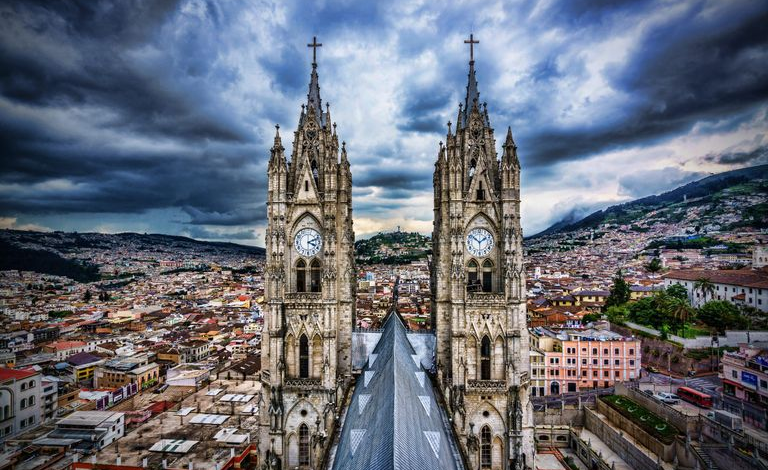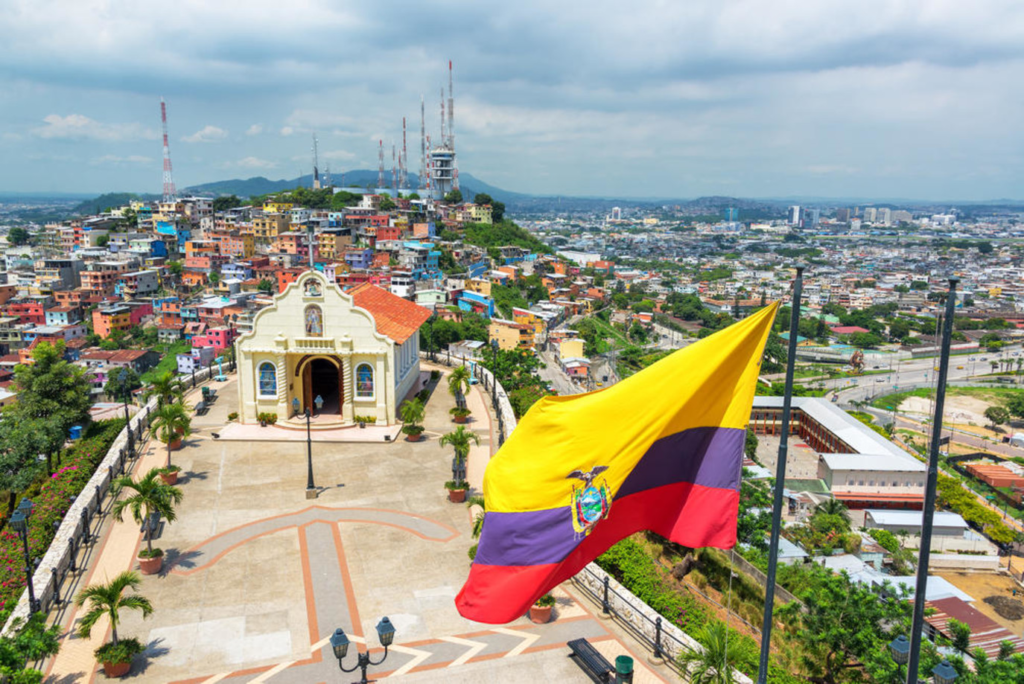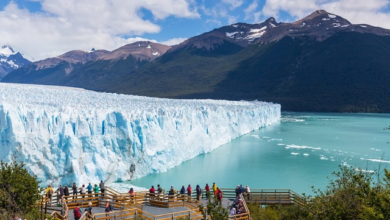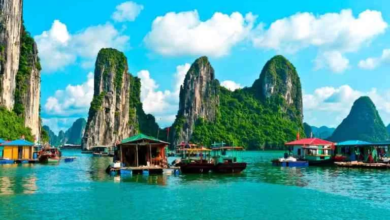Exploring the Enchanting Landscapes of Ecuador: A Journey into Nature’s Embrace

Introduction:
Travel and tourism have the power to transport us to fascinating destinations, where we can immerse ourselves in diverse cultures, breathtaking landscapes, and create lasting memories. One such captivating country is Ecuador, a land of enchantment nestled in the heart of South America. With its stunning natural wonders, vibrant cities, and warm hospitality, Ecuador offers a unique travel experience that caters to the adventurer, the nature enthusiast, and the cultural aficionado.
Paragraph 1: Captivating Natural Landscapes
Ecuador is a treasure trove of natural beauty, boasting an incredible variety of landscapes. From the majestic peaks of the Andes Mountains to the lush Amazon rainforest and the pristine beaches of the Pacific coast, the country offers an awe-inspiring tapestry of ecosystems. One cannot miss the chance to stand in awe of the iconic Cotopaxi volcano, hike through the mystical cloud forests of Mindo, or explore the captivating Galapagos Islands, a haven of biodiversity that inspired Charles Darwin’s theory of evolution.
Paragraph 2: Embracing Cultural Heritage
Beyond its natural wonders, Ecuador is a melting pot of cultures and traditions. Its rich indigenous heritage is evident in the colorful markets of Otavalo, where artisans proudly display their handcrafted textiles and intricate jewelry. Travelers can also immerse themselves in the fascinating history of Quito, the country’s capital, declared a UNESCO World Heritage site for its well-preserved colonial architecture and charming cobbled streets. Exploring the narrow alleys of Cuenca, another UNESCO gem, offers a glimpse into Ecuador’s cultural past, with its stunning churches, plazas, and vibrant arts scene.
Paragraph 3: Adventures in Outdoor Exploration
For the adventurous souls seeking adrenaline-pumping experiences, Ecuador is a playground of thrilling activities. Embarking on a trek through the Avenue of the Volcanoes allows hikers to conquer challenging peaks, bask in breathtaking panoramas, and discover remote indigenous communities along the way. Rafting down the roaring rivers, biking through scenic landscapes, and zip-lining above lush canopies are just a few of the exhilarating adventures that await outdoor enthusiasts.
Paragraph 4: Ecotourism and Conservation Efforts
Ecuador has made commendable strides in ecotourism and environmental conservation. The country’s commitment to sustainability is evident in its protected areas, such as the Yasuni National Park, home to an astounding array of species. Visitors can engage in responsible tourism practices by staying at eco-lodges, participating in community-based tourism initiatives, and supporting local conservation projects. By doing so, travelers can contribute to the preservation of Ecuador’s natural heritage and ensure its beauty endures for generations to come.

In addition to Quito, which was mentioned in the essay, Ecuador is home to several other UNESCO World Heritage sites. Here are a few notable ones:
- Galapagos Islands: The Galapagos Islands, located in the Pacific Ocean, are a remarkable archipelago renowned for their unique biodiversity and their contribution to Charles Darwin’s theory of evolution. The islands are a living laboratory, with numerous endemic species and diverse ecosystems that have remained relatively untouched by human influence.
- Sangay National Park: Located in the central Andes region, Sangay National Park is a UNESCO World Heritage site recognized for its outstanding natural beauty and exceptional volcanic landscapes. The park is home to three active volcanoes, dense cloud forests, and diverse wildlife, including the endangered Andean condor.
- Historic Center of Santa Ana de los Ríos de Cuenca: Cuenca, often referred to as the “Athens of Ecuador,” is a picturesque city with a well-preserved historic center. The area showcases a blend of architectural styles, including colonial, republican, and neo-gothic, and is home to numerous churches, plazas, and cultural institutions.
- Qhapaq Ñan, Andean Road System: This extensive road network, also known as the Inca Trail, stretches across several countries, including Ecuador. Qhapaq Ñan was a vital communication and transportation route during the Inca Empire and is recognized for its cultural and historical significance.
- Macchu Picchu and Qhapaq Ñan, Peru (with Ecuador): Although primarily located in Peru, Macchu Picchu, an ancient Inca citadel, and the associated Qhapaq Ñan sections that extend into Ecuador are jointly recognized as a UNESCO World Heritage site. Macchu Picchu is an iconic archaeological site, often referred to as the “Lost City of the Incas,” and is a testament to the remarkable achievements of the Inca civilization.
These UNESCO World Heritage sites highlight Ecuador’s diverse natural and cultural heritage, offering visitors the opportunity to explore and appreciate the country’s remarkable history and natural wonders.

The historic center of Cuenca, a UNESCO World Heritage site, is replete with cultural institutions and landmarks that showcase the city’s rich heritage. Here are some notable ones:
- Cathedral of the Immaculate Conception: Located in the heart of Cuenca’s historic center, the grand Cathedral, also known as Catedral Metropolitana de la Inmaculada Concepción, dominates the city’s skyline. This stunning example of neoclassical architecture houses religious artworks and offers breathtaking views from its towers.
- Plaza de las Flores: This charming square, known as the “Flower Plaza,” is a vibrant hub in Cuenca’s historic center. It is lined with colorful flower stalls, local handicraft vendors, and traditional food carts, creating a lively atmosphere that embodies the city’s cultural essence.
- Church of San Francisco: The Church of San Francisco is an architectural gem that showcases a mixture of Baroque and Moorish influences. Its elaborately adorned façade, intricate woodwork, and beautiful interior make it a must-visit landmark in Cuenca.
- Museo de Las Conceptas: Housed within a former convent, the Museo de Las Conceptas offers a glimpse into the history and daily life of the nuns who once resided there. The museum exhibits religious art, artifacts, and showcases the convent’s architectural features, including the impressive cloister.
- Pumapungo Archaeological Park: Located on the outskirts of the historic center, Pumapungo Archaeological Park is an expansive site that preserves the ruins of an ancient Inca city. Visitors can explore the remnants of temples, plazas, and ceremonial baths, gaining insight into the region’s pre-Columbian history and culture.
- Museo del Banco Central: The Museo del Banco Central, or Central Bank Museum, is a comprehensive cultural institution that exhibits Ecuadorian art, archaeology, and ethnography. It houses an extensive collection of pre-Columbian artifacts, colonial-era art, and contemporary works, providing a comprehensive overview of Ecuador’s artistic heritage.
These cultural institutions and landmarks are just a few examples of the many treasures awaiting visitors in Cuenca’s historic center. Whether it’s exploring the architectural wonders, delving into the city’s history, or immersing oneself in its vibrant arts scene, Cuenca offers a captivating cultural experience.

Cuenca’s historic center is a hub of activity, offering a range of popular activities and events that showcase the city’s vibrant culture and traditions. Here are some notable ones:
- Festival of Cuenca (Fiesta de Cuenca): This annual celebration takes place in November and commemorates the founding of the city. The festival features parades, traditional music and dance performances, street parties, and colorful processions. It’s a fantastic opportunity to experience the lively atmosphere and immerse yourself in Cuenca’s cultural heritage.
- Artisan Markets: Cuenca is renowned for its skilled artisans, and the historic center is dotted with markets where you can find an array of handcrafted goods. The Plaza de las Flores and Plaza San Francisco are popular spots to browse and purchase traditional textiles, pottery, jewelry, and other local crafts.
- Gastronomic Delights: Cuenca’s historic center is a culinary haven, offering a wide range of traditional Ecuadorian cuisine. Visitors can indulge in local delicacies such as cuy (roasted guinea pig), hornado (roast pork), and fanesca (a traditional soup). Exploring the vibrant food scene and trying out the various markets, cafes, and restaurants is a must for food enthusiasts.
- Art Walks: Cuenca is known for its thriving arts scene, and the historic center is home to numerous galleries and art studios. Art walks are a popular activity, allowing visitors to explore the diverse art forms and interact with local artists. The Pumapungo Archaeological Park often hosts art exhibitions and cultural events, providing a unique blend of history and contemporary art.
- Cultural Performances: Various theaters and cultural centers in the historic center showcase traditional music, dance, and theatrical performances. The Teatro Sucre, a beautifully restored theater, hosts concerts, ballets, and theatrical productions throughout the year. Attending a performance offers a wonderful opportunity to witness Ecuadorian performing arts at their finest.
- Walking Tours: Exploring the historic center on foot is a popular activity in itself. Guided walking tours are available, allowing visitors to discover the city’s architectural gems, learn about its history, and explore hidden corners. These tours often cover landmarks such as the Cathedral, Plaza de las Flores, and the Church of San Francisco, providing insights into Cuenca’s rich cultural heritage.
These activities and events provide a glimpse into the vibrant cultural scene of Cuenca’s historic center. Whether you’re seeking traditional festivities, artistic experiences, culinary delights, or simply strolling through its charming streets, the historic center of Cuenca offers a captivating blend of history, culture, and entertainment.
Cuenca’s historic center is brimming with landmarks and attractions that captivate visitors with their architectural beauty, historical significance, and cultural charm. Here are some more popular landmarks and attractions in Cuenca’s historic center:
- Calderón Park: Located at the heart of the historic center, Calderón Park is a central gathering place surrounded by beautiful colonial buildings. The park is adorned with gardens, fountains, and a statue of the city’s independence hero, Abdón Calderón. It’s an ideal spot to relax, people-watch, and soak up the ambiance of the city.
- New Cathedral (Catedral de la Inmaculada Concepción): Adjacent to Calderón Park, the New Cathedral is an iconic landmark that showcases stunning Neo-Gothic architecture. Its towering blue domes and intricate detailing make it a must-visit site. The interior is equally impressive, featuring intricate stained glass windows and ornate altars.
- El Barranco: El Barranco is a picturesque neighborhood located along the banks of the Tomebamba River. Known for its narrow cobblestone streets, colorful houses, and scenic viewpoints, it offers a charming glimpse into Cuenca’s past. The Puente Roto (Broken Bridge) is a popular spot for panoramic views of the city.
- Mirador de Turi: Located just outside the historic center, Mirador de Turi offers breathtaking views of Cuenca and its surroundings. From this vantage point, visitors can capture panoramic vistas of the red-tiled roofs, domes, and spires that dot the city’s landscape.
- Todos los Santos Ruins: These archaeological ruins, situated in the heart of the city, offer a glimpse into Cuenca’s pre-Columbian past. Excavated in the late 20th century, the site contains remains of ancient Inca and Cañari structures, including ceremonial platforms, tombs, and ancient pathways.
- Pumapungo Archaeological Park and Museum: As mentioned earlier, Pumapungo Archaeological Park is located near the historic center. It features extensive Inca ruins, including a reconstructed Inca palace and ceremonial center. The park also houses the Pumapungo Museum, which exhibits artifacts and provides insights into the region’s ancient civilizations.
These landmarks and attractions in Cuenca’s historic center offer visitors a chance to delve into the city’s architectural heritage, immerse themselves in its history, and appreciate its natural beauty. Exploring these sites will undoubtedly deepen your appreciation for the cultural and historical richness of this remarkable city.
Conclusion:
A journey to Ecuador is an invitation to embark on a captivating adventure that transcends the ordinary. It is a place where nature’s grandeur intertwines with vibrant cultures, offering a profound connection to the world around us. Ecuador’s remarkable landscapes, rich cultural heritage, and commitment to sustainable tourism create an experience that nourishes the soul and ignites a sense of wonder. As you explore Ecuador’s remarkable diversity, you will not only leave footprints on its soil but also carry cherished memories and an appreciation for the beauty that lies within our world.
https://youtravel.tp.st/nW8tlAlc



Magnificent beat I would like to apprentice while you amend your site how can i subscribe for a blog web site The account helped me a acceptable deal I had been a little bit acquainted of this your broadcast offered bright clear idea
Wow wonderful blog layout How long have you been blogging for you make blogging look easy The overall look of your site is great as well as the content